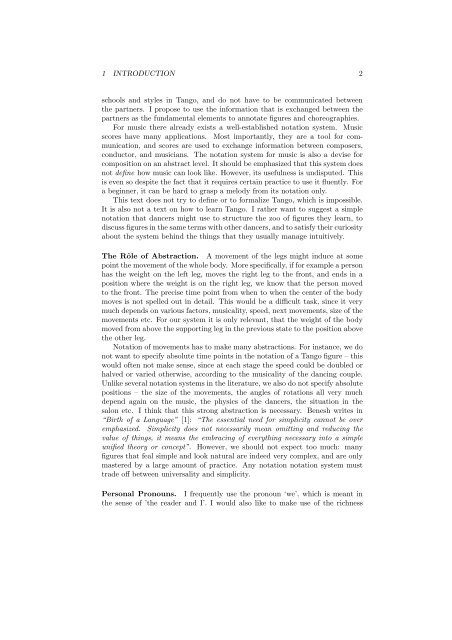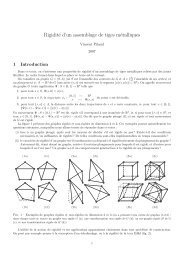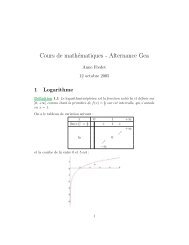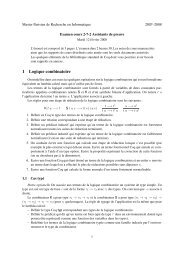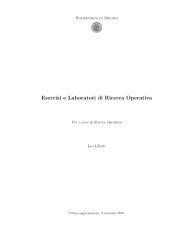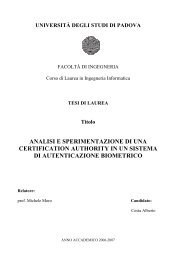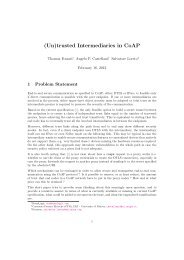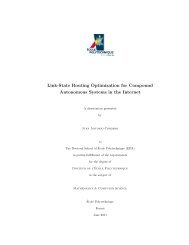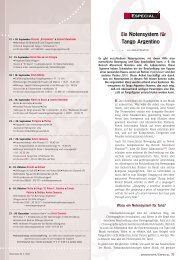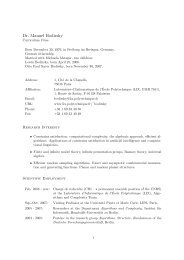Create successful ePaper yourself
Turn your PDF publications into a flip-book with our unique Google optimized e-Paper software.
1 INTRODUCTION 2<br />
schools and styles in <strong>Tango</strong>, and do not have to be communicated between<br />
the partners. I propose to use the in<strong>for</strong>mation that is exchanged between the<br />
partners as the fundamental elements to annotate figures and choreographies.<br />
For music there already exists a well-established notation system. Music<br />
scores have many applications. Most importantly, they are a tool <strong>for</strong> communication,<br />
and scores are used to exchange in<strong>for</strong>mation between composers,<br />
conductor, and musicians. The notation system <strong>for</strong> music is also a devise <strong>for</strong><br />
composition on an abstract level. It should be emphasized that this system does<br />
not define how music can look like. However, its usefulness is undisputed. This<br />
is even so despite the fact that it requires certain practice to use it fluently. For<br />
a beginner, it can be hard to grasp a melody from its notation only.<br />
This text does not try to define or to <strong>for</strong>malize <strong>Tango</strong>, which is impossible.<br />
It is also not a text on how to learn <strong>Tango</strong>. I rather want to suggest a simple<br />
notation that dancers might use to structure the zoo of figures they learn, to<br />
discuss figures in the same terms with other dancers, and to satisfy their curiosity<br />
about the system behind the things that they usually manage intuitively.<br />
The Rôle of Abstraction. A movement of the legs might induce at some<br />
point the movement of the whole body. More specifically, if <strong>for</strong> example a person<br />
has the weight on the left leg, moves the right leg to the front, and ends in a<br />
position where the weight is on the right leg, we know that the person moved<br />
to the front. The precise time point from when to when the center of the body<br />
moves is not spelled out in detail. This would be a difficult task, since it very<br />
much depends on various factors, musicality, speed, next movements, size of the<br />
movements etc. For our system it is only relevant, that the weight of the body<br />
moved from above the supporting leg in the previous state to the position above<br />
the other leg.<br />
<strong>Notation</strong> of movements has to make many abstractions. For instance, we do<br />
not want to specify absolute time points in the notation of a <strong>Tango</strong> figure – this<br />
would often not make sense, since at each stage the speed could be doubled or<br />
halved or varied otherwise, according to the musicality of the dancing couple.<br />
Unlike several notation systems in the literature, we also do not specify absolute<br />
positions – the size of the movements, the angles of rotations all very much<br />
depend again on the music, the physics of the dancers, the situation in the<br />
salon etc. I think that this strong abstraction is necessary. Benesh writes in<br />
“Birth of a Language” [1]: “The essential need <strong>for</strong> simplicity cannot be over<br />
emphasized. Simplicity does not necessarily mean omitting and reducing the<br />
value of things, it means the embracing of everything necessary into a simple<br />
unified theory or concept”. However, we should not expect too much: many<br />
figures that feal simple and look natural are indeed very complex, and are only<br />
mastered by a large amount of practice. Any notation notation system must<br />
trade off between universality and simplicity.<br />
Personal Pronouns. I frequently use the pronoun ‘we’, which is meant in<br />
the sense of ’the reader and I’. I would also like to make use of the richness


